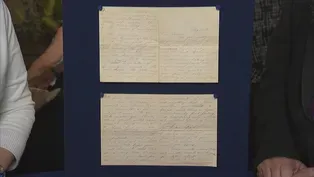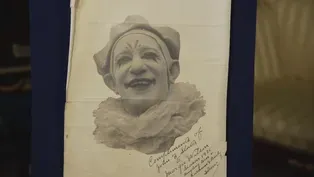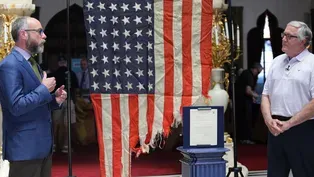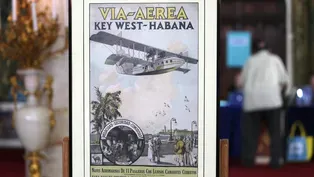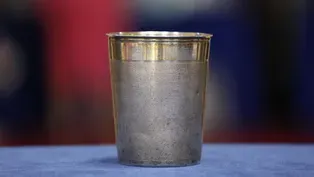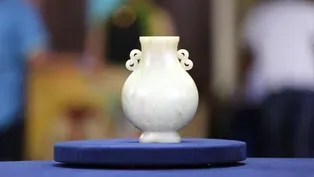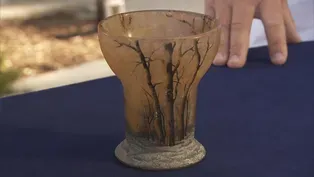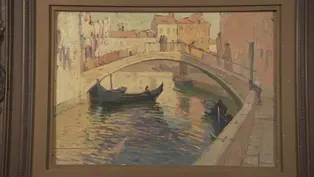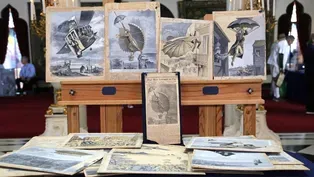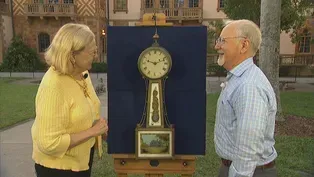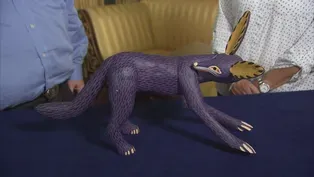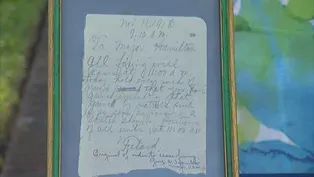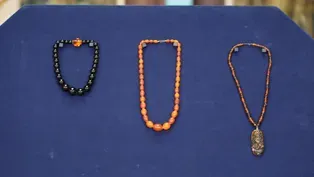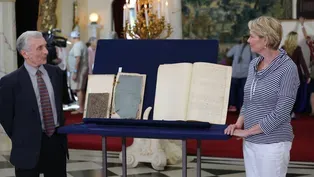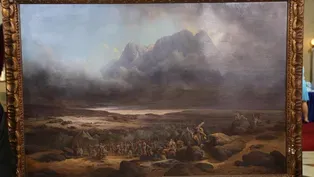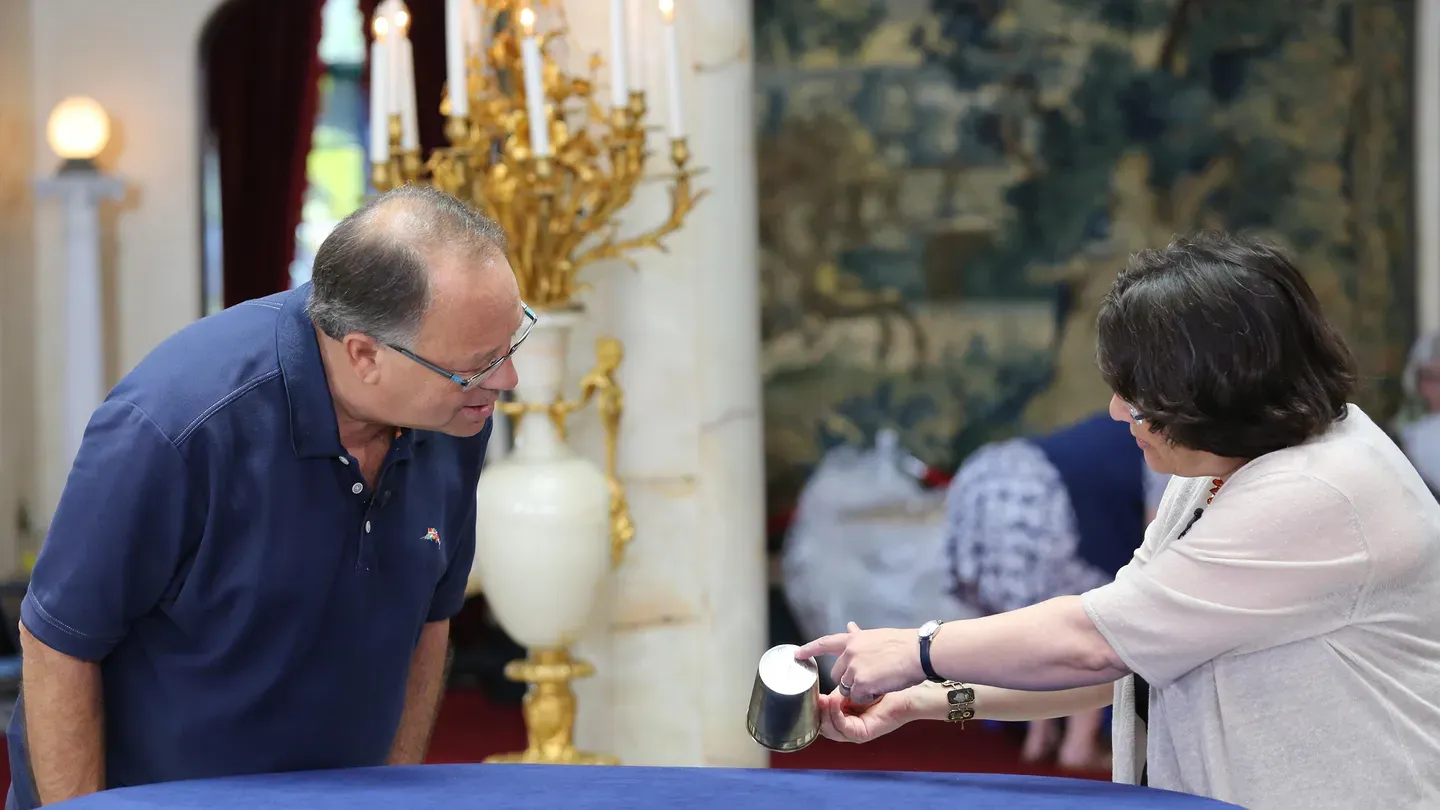

Ca' d'Zan, Hour 2
Season 23 Episode 5 | 52m 30sVideo has Closed Captions
Head to Ca' d'Zan to discover treasures fitting for a grand celebration!
Head to Ca' d'Zan to discover ROADSHOW treasures that are fitting for a celebration of “the greatest show on Earth,” like an 1866 Otto Georgi painting, an Augsburg silver Kiddush cup, and “How Man Learned to Fly" illustrations. One is up to $30,000!
Problems with Closed Captions? Closed Captioning Feedback
Problems with Closed Captions? Closed Captioning Feedback
Funding for ANTIQUES ROADSHOW is provided by Ancestry and American Cruise Lines. Additional funding is provided by public television viewers.

Ca' d'Zan, Hour 2
Season 23 Episode 5 | 52m 30sVideo has Closed Captions
Head to Ca' d'Zan to discover ROADSHOW treasures that are fitting for a celebration of “the greatest show on Earth,” like an 1866 Otto Georgi painting, an Augsburg silver Kiddush cup, and “How Man Learned to Fly" illustrations. One is up to $30,000!
Problems with Closed Captions? Closed Captioning Feedback
How to Watch Antiques Roadshow
Antiques Roadshow is available to stream on pbs.org and the free PBS App, available on iPhone, Apple TV, Android TV, Android smartphones, Amazon Fire TV, Amazon Fire Tablet, Roku, Samsung Smart TV, and Vizio.
Buy Now

ANTIQUES ROADSHOW 2025 Tour!
Enter now for a chance to win free tickets to ANTIQUES ROADSHOW's 2025 Tour! Plus, see which cities we're headed to!Providing Support for PBS.org
Learn Moreabout PBS online sponsorshipMARK WALBERG: "Antiques Roadshow" is amazed by the treasures turning up at the Ca' d'Zan in Sarasota, Florida.
That is a lot of hood ornament.
It's a lot of dragonfly.
Wow!
Oh, my goodness.
♪ ♪ WALBERG: Ca' d'Zan, the former home of circus man John Ringling and his wife, Mable, was the private show-stopper of a residence built on Ringling's success entertaining the masses.
John and Mable both came from humble beginnings, but by the time this magnificent mansion was completed in 1926 for over one-and-a-half million dollars, the Ringlings were living the American dream.
Ten years later, when John Ringling died in December of 1936, reportedly with only a few hundred dollars in his bank account, he left Ca' d'Zan, the Ringling art museum, and its art collection to the State of Florida.
All are now part of Florida State University.
John Ringling's circus was called "The Greatest Show on Earth," but what great treasures have come to "Roadshow"?
Take a look.
♪ ♪ This is a collector guitar.
Yes.
If you were collecting Gibson semi-hollow-body guitars, you would want to have maybe the only 1958 Plectrum they made.
Four-string.
I brought some old Valentines.
And I'm super-excited to be here!
And the valentine is dated February 14, 1897.
♪ ♪ It was in my father's steamer trunk from probably the late '20s.
As I recall the story from him, he saved the hood ornament from an automobile he was driving in Canada, and he wrecked the car and saved the hood ornament.
Apparently, that was all that was savable.
And was injured, had a scar on his nose from the accident, and this was what was left of the car.
Which survived intact, I might add.
Survived intact.
Absolutely.
So this is a Lalique car mascot, or hood ornament.
It was first designed and introduced in 1928.
It's called, "Grande Libellule," which means, "big dragonfly."
"Big dragonfly"?
Right.
It's interesting because, when it left the factory, it was frosted and clear glass.
So we know that it was exposed to sunlight and it was used probably for a good amount of time, because it has a slight pale amethyst tinge to it.
And that happens because there was manganese in the glass, and that would react with the sunlight, and over time, it would turn amethyst.
Now, some people think that's a bad thing, but when it happens naturally, it's okay by me.
It is considered, in the Lalique world, to be a good thing.
And, in a retail store, a piece like this would bring between $8,000 and $10,000.
Wow!
That is a lot of hood ornament.
Yeah, it's a lot of dragonfly.
A lot of dragonfly.
♪ ♪ MAN: I got it in Gettysburg, Pennsylvania, at an outdoor flea market, about 35 years ago.
Had to pay $40 for it.
And what was it about the poster that appealed to you?
Well, obviously, the graphics, but the aviation theme appealed to me, because that was my business at one point.
Certainly being in the aviation industry, I can see why pictures of old planes would hold some appeal.
Right.
Yes, absolutely.
What was your role in the aviation industry?
We leased turbo-prop aircraft, which would have been the follow-on to this type of aircraft here.
But this was from 1920 to 1924, this airline was in service.
Yes, so, exactly right.
The airline is the Aeromarine West Indies Airways company, and they were founded in 1920.
They went out of business in 1924 over some airmail dispute with the U.S. government.
Right.
And in 1921 the airline changed their name, which helps us identify this poster really as being from about 1920, before the airline changed their name.
Wow.
And it's a wonderful poster, which very prominently features this aircraft.
I should point out the airplane, the Santa Maria, was known as sort of the belle of the fleet.
The Aeromarine West Indies flew between Key West and Havana.
Right.
So, for a collector, a collector will see this and say, "Wow, that is a great aircraft."
A separate collector from an entirely different collecting subcategory would say, "What a great piece of Cuban history," right?
It's the bay in Havana, it's the Castillo, the fort, the Castillo de Tres Reyes...
Right.
Reyes del Morro, one of the great landmarks of Havana.
It is in Spanish, and versions do exist in English, as well.
Okay.
And on the English version, instead of "Velocidad," it would say, "Speed, Safety, and Comfort."
I see.
The word "carlinga" means "cabin," so they're actually showing a picture of what the cabin looks like inside.
I see.
So this is a lithograph poster...
Okay.
...that was designed by an artist named Winchell, who worked out of New York.
He is actually an unknown graphic designer-- there is no other pieces that I could find to his name.
Lithography was a very common form of printing for advertising agencies from the 1870s through the era between the first and second world wars.
It's not in great condition.
I notice that it's faded.
Now, I'm going to be very honest with you, I have never seen one of these in person before.
There's an absence of reds and orange tones, which are the first to go in bright light.
How much did you pay for it?
$40.
So when you bought it for $40, you probably thought, "This is a pretty nice piece for $40."
Yeah.
"It's not in great shape, but it doesn't matter, because it's only $40."
Right.
This piece is actually extraordinarily rare.
Right.
The Smithsonian Institution, the Air and Space Museum, they have a copy in their collection, but one has never come on the market before.
I see.
And my opinion, were this to come up for auction now, an estimate would be between $4,000 and $6,000.
Wow.
And I'm being conservative, because I don't want to let my optimism get away with me.
Conceivably, it could sell for substantially more.
Well, that's fantastic, that's fantastic.
Pretty good.
If it were in mint condition, I would imagine at auction it could fetch as much as $7,000 to $10,000.
Wow.
(talking in background) Well done, sir.
Thank you.
I actually have this piece, it's from our family, it's from an aunt out of New York City.
Apparently, she lived on Fifth Avenue, and that's about all I know about it.
APPRAISER: So this was published in 1964, and you already have an indication here that it is more of a mass-market-produced book, not a first edition.
And it says "trade edition."
WOMAN: Okay.
So it was probably a special edition made at that time.
You did well, didn't pay much, right?
(both laughing) Yeah, she bought it for a dollar.
Right, and that's pretty much what it's worth.
Yeah, that's okay.
I brought a photograph of a clown from the Ringling Brothers, Barnum and Bailey Circus, with compliments to my grandmother, who actually ran away, left her young son.
Gave him the decision to stay either with his stepdad or to go with her to join the circus.
And I assume it was because her second marriage, to her sister's husband, was not working out well.
So she joined the circus, and this is about five years after she joined.
So... That's a great story.
Yes.
(laughs): Really exciting.
Well, this gelatin silver photograph would have been a souvenir at the time.
It's says, "Compliments of John F.
Slater."
John F. Slater was the head clown in 1921, or here is referred to as "the chief clown."
Okay.
It's dated 1921, so we know exactly when it's from.
Today, the equivalent would be a headshot that a celebrity would give to a fan.
Okay.
What's really great about this is, it's a piece of memorabilia at the heyday of the traveling show.
And it's particularly poignant, because the circus closed in 2017.
I know.
So it's kind of a souvenir of a bygone era.
Absolutely.
If I were valuing this for auction, I would estimate this print at $100 to $200.
Oh, wow, okay.
Well, it has so much meaning.
Of course.
But the money is...
But I'm even surprised it's worth that.
That's wonderful.
♪ ♪ WALBERG: Ca' d'Zan was arguably at its best when the Ringlings hosted lavish parties.
Singers would perform from the second-floor mezzanine, looking down onto the guests gathered in the grand courtroom below.
♪ ♪ Well, my great-great-grandfather was a whaler, and so, some of these were for me.
I had the, all the scrimshaw, and my cousin had all the journals.
And he gave the journals to me, so it would be a complete set.
So that's why I, I just acquired the journals within the last couple of years.
So, it's all together now.
Have you read the journals?
I've read a little bit.
Two of them are very old, they scared me a little bit to open them, because they were so fragile.
Well, I'm happy you brought them in.
They're a lot of fun.
We actually have three journals here, and a tooth.
They are whaling.
I'll say the one closest to you, actually, it wasn't as much a whaling trip, at least from what I could read of it, as he was bringing supplies out to California in 1849.
Yes, right.
And of course...
The Gold Rush.
1849 is an important time in the Gold Rush.
Yeah, yeah.
And when you start reading through some of the pages, most of it is what the weather's like, and that is very typical.
The other two, on this side, closer to me, are whaling journals.
Now, the first one we have is out of New Bedford, and it's from 1846.
And it's describing going out and getting whales, which is what a lot of these images are.
And as you read through a journal like this, when you see the images of the whales, the whale tails, that's telling you that they were successful.
And it was an incredibly dangerous business.
A lot of people romanticize it.
But going out in a small boat and trying to kill and capture a whale was dangerous.
It's a great journal, and it gives a good accounting, and they were very successful.
So he must, must have been a good captain.
Now, the one that I particularly liked was this journal on the Amazon.
It starts in 1839, and this one goes even into the 1840s.
But what really makes this one interesting, and sort of way above the others is, he was going to Australia.
Yeah.
And 1840s, 1830s, for Australia, is actually pretty early.
And there are a lot of very, very avid collectors of any early material on Australia.
So, one, you have a nice journal going to California, one, New Bedford, those show up.
But then you have the Australia one, and you have the scrimshaw, that just sort of united everything.
Yes.
And one of the nice things about why we wanted to show this tooth is, this tooth is in the 1830s, 1840s, so it fits in perfectly with the journals.
Also, it's a nice tooth, but not terribly beautifully done.
My colleague said that the whale's tooth is probably around $500, somewhere in that range.
Mm-hmm.
The journal of going out to California is probably in the $500 to $1,000 range.
Okay.
The journal from New Bedford is probably in the $1,000 to $2,000 range.
Mm-hmm.
But, the special one is Australia.
I would say, conservatively, and this is all retail value, conservatively, it's in the $5,000 to $10,000 range.
My father-in-law and my mother-in-law were collecting antiques in the Boston area in the mid-1950s.
So I don't know who they bought it from, whether it was an auction or a dealer, I have no idea.
But it's been in their home and then my home for all this time.
We love it, but we don't know much about it.
All right, well, this clock is definitely made in Massachusetts.
It was based on a patent that Simon Willard received in 1802.
A banjo timepiece, or patent timepiece, as he called it, is strictly an American innovation.
This was not an idea that came from England.
Oh, cool.
The ability to have an eight-day clock in such a compact case was something, at the time, they needed a huge drop for a week's worth of time.
But he figured out a way to make it short.
Hmm.
So as a result, this clock was patented.
It was very expensive in its day, the original Simon Willard models.
Well, his patent was used by other clockmakers at the time.
This particular one, we think, was made by John Stowell in Charlestown.
And I wouldn't have known that just looking at the clock, but when you brought it in, I opened the door, and inside the door is a watch paper.
It's got the tag.
Right, and it says, "John Stowell, Charlestown."
And it does say, "Sold in 1833."
It's very interesting.
Right.
Because I think the clock's a little older than that.
I don't know whether the clock may have been sold secondhand.
I asked some of my compatriots in there.
We think this clock was made in the, maybe 1815 or '20.
The finial would appear to be original, the dial has never been repainted-- they often are.
Yeah.
That's a good thing.
We think the throat tablet is original.
There's some flaking, but it's there.
Right.
The lower tablet is a replacement.
Right.
And they often are, because they're so fragile, and the gilding has been painted over with radiator paint.
Well, that sounds like a whole bunch of problems, but they don't add up to that much hurt, as far as I'm concerned.
Okay.
These clocks aren't worth as much as they used to be, but I think for insurance purposes, you might consider insuring it at, let's say, around $1,000.
Okay, excellent.
It's a beauty.
It is a beauty, so that's good to know.
Yeah.
This is from Mexico.
Oh, okay.
Chupícuaro.
Archaeological dig.
And you went to Mexico, and you got it there?
No, I didn't, I found it in a thrift shop here in Sarasota.
Wow!
Because of its size, I knew that it wasn't just a trinket.
Yeah, that's for sure.
So...
So where do you think it's from?
Mexico-- Chupíc-UAR-o.
All right, Chu-PÍC-uaro.
Chu-PÍC-uaro.
Okay, you know, let's just try to sit this thing upright.
So, it's Chupícuaro.
So you did a little bit of research.
Yes, a little bit, and I found out that... And so what did you learn?
Well, I found out that, uh, it's a controversial piece.
Why is it controversial?
It's controversial because nobody can really figure out whether it is real or not.
So, you're pretty convinced this thing is real.
No, I'm not.
Okay, all right, well, you and I are together on that.
Right.
Yeah.
This is a 20th-century piece.
I, I figured that.
Yeah, it's 20th-century, but it is very, very large.
Now, Chupícuaro, which is in Mexico, as you know...
I know that.
They, they do have objects this big.
The way the shoulders are treated, and, and it's a little bit clunky, the painting is kind of a bit overdone.
Uh-huh.
And so when you add all of that up, then you know it's a red flag and it's a 20th-century piece.
Right.
Right.
You want to know what the value is.
Well, at least $45, I hope.
You're going to do a lot better than that.
Oh, really?
This would be on the decorative market.
So if this were in a really nice showroom in Dallas or L.A. or New York or wherever, I wouldn't be at all surprised to see this thing, $1,000 to $1,500.
Really?
Yeah.
And one thing I know for sure, you didn't buy this by the pound, did you?
(chuckling): No.
This is very heavy.
Yes.
And, and we're glad this segment doesn't go 30 minutes.
♪ ♪ WALBERG: The Ringlings repurposed many elements of their home, like thousands of ceramic roof tiles from demolished buildings in Granada, Spain; and the crystal chandelier in the courtroom that once hung in the old Waldorf Astoria Hotel in New York City.
It's a Kiddush cup that's been used for wine in Jewish ceremonies.
It's been handed down in my family for as far back as I know, as my grandfather, who was born in 1877.
There's a lot of history on the bottom of the cup.
So it's pretty plain when you look at it.
Yes.
But it has this terrific crest on the bottom, a name, and also tells us where it was made and about when.
Does it?
It has an inscribed date of 1654.
Yes.
Which is early.
Yes.
We rarely see silver, or any item, that goes back quite that far.
Right.
And it has sort of the pinecone mark, which is for Augsburg.
Okay.
So it was made in...
In Germany.
In Germany.
Okay.
In Southern Germany, Bavaria.
Right, right, that's where my family was from.
Okay, so, do you know much of their history?
My mother grew up in Southern Germany in a... south of Munich, a town called Neustadt an der WeinstraBße.
In 1938, the family emigrated from Germany to the United States.
My grandfather was... had a business in the town.
They lived in the house above the business, selling sheets and linens and things like that.
And when he was arrested, my grandmother tried to sell the house.
It was before the Final Solution.
They weren't gassing the Jews yet in '38.
So, she sold the house to her brother, my grandmother did, because he said, "We're Germans.
"They're not going to take us away, they're not going to harm us."
And of course they were all exterminated later on.
But my grandmother got the money from her brother, sold the house and the business, and then paid off the guards at the concentration camp, got my grandfather out.
My uncle was there also, my mother's brother.
Got them out, got the family to England and sailed to America.
She managed to take this cup with her and also a menorah, a candelabra.
A Hanukkah menorah, yeah.
And the clothes on their back.
It gives you shivers, I think.
It does.
Sort of thinking about the history.
And what is particularly interesting is, today is Yom HaShoah.
It's Holocaust Remembrance Day.
Yes.
So it's very, very fitting that we are looking at an object that survived the horrible effects...
Yes-- the Holocaust.
... of the Holocaust and World War II, and is continuing to be, you know, in the family and to be carried forward.
Yes.
Augsburg was a center for silver manufacturing.
There weren't Jews in Augsburg in this time period.
Okay, right.
They had been expelled, but certainly lived in surrounding areas.
And Jews also were not allowed to be members of professional craftsmen's guilds.
Oh, okay.
So they would employ Christian silversmiths to make things for ceremonial use.
Right.
Right.
So it, as you said, it's been used as a Kiddush cup.
There aren't any identifications that cement that in...
Okay.
Sometimes Kiddush cups will have, will have an inscription.
Right.
Either part of a blessing, they'll have a snippet of text.
Or a star of David, maybe.
They'll have a dedication inscription, able to trace.
Right.
I think what is fascinating would be to try to figure out who the prior owner was, because this is a heraldic or crest or emblem.
Okay.
So, unlikely Jewish, but it would give us a little more background.
Yes.
So is this something that is used?
Do you use it for... We do use it.
We do use it... For Shabbat and for holidays?
For Rosh Hashanah and the holidays, we do.
Yeah, and it's the right size.
Kiddush cups need to hold a certain amount of wine to be kosher.
Right.
And this, certainly you could fit four ounces in there without any problem.
I suppose so.
On the market, this form of cup is not that unusual.
Right.
They come up pretty regularly.
There's a maker's mark that I haven't been able to identify, but maybe with some work, could be figured out.
Right, okay.
So, on face value, knowing that it's 17th-century...
Right, right.
It's Augsburg, it's silver gilt, with a lot of questions still...
Right.
I would say an auction estimate would be between $2,500 and $3,500.
Right, okay.
Jewish items that are sort of in continuous Jewish use from this time period, even the 18th century, are very rare.
Yes, right.
What an important item it was to bring with them, leaving in such haste is, you know, is telling.
Right, sure, sure.
I know.
Well, one of the items is a vintage 1930s Louis Vuitton suitcase.
And I paid $1,300.
My mother got that in 1970 from an antique dealer in Warm Springs, Georgia.
It's been hanging on our mantle, literally, almost my whole life.
And she said she paid $250 for it, so I'm sure the guy was asking $750, 'cause she's never paid anything... retail for anything in her life, so... Good bargainer.
Well, the gun is kind of a classic example of a Southern-style po boy rifle.
This is a working gun.
"We're going to go hunt with it, we're going to get some food for the table."
WOMAN: All I know is that it's from Mexico.
I did a little bit of investigation on it, and I think it was a father and maybe two sons and a daughter that were very creative and great carvers.
Where did you get it?
Yard sale.
Here in Florida, or...?
Yes.
Jiménez is who did it, from Oaxaca, Mexico.
Okay.
And he kind of founded a dynasty.
He was born in the early 20th century and lived up to 2005, and became famous for these carvings.
His animals are these animated, dynamic figures.
And it's signed completely on the bottom.
It was probably carved in the 1990s.
The family also did prints of the animals, because they couldn't carve enough to supply their market.
So he became quite well known in his, in all the books on folk art of Mexico and is in most major collections of Mexican folk art.
Oh.
An animal this scale and signed like this would probably bring between $800 and $1,000.
Oh, wow.
So, I don't know what you paid for it, but...
I can't remember specifically, but I think it's under ten dollars or around ten dollars, so... Well, you're okay.
Yeah, oh, wonderful.
Thanks for bringing it, it's a great piece.
Well, thank you.
Oh, that was wonderful information.
Thank you, I really appreciate it.
♪ ♪ WALBERG: John Ringling was a Freemason.
Decorative elements of the house reflect his membership in this secretive club, such as the black-and-white floors in the court and the terracotta all-seeing eye on the exterior of the house.
My father had collected these 35 years ago.
And he was a college art professor, and he loved painting.
And he bought these in Sarasota, and five years later, I inherited them.
And they've been in my collection for 30 years.
And you know where they came from originally, where they were published?
These were from "The Boston Post."
They were used for a magazine called "How Man Learned to Fly," by Theodore Hedlund.
These are the illustrations that were used in the publication.
That's right, and how many are there altogether?
There are 24 illustrations, and it also came along with a bunch of photographs, as well.
These are great illustrations done in gouache.
Yes.
They're camera-ready, which means they were able to just shoot them right into the paper, as you can see with the flying man.
Right there, here's the flying man matching up to the camera-ready gouache illustration that you have there on board.
And that particular one was done in 1919.
What's even more interesting to me is, it's not just aviation-related, which is fascinating in and of itself, because it's early aviation, but it has a science fiction, fantasy, kind of futuristic touch to it.
Yes, it does.
Pretty much like Frank R. Paul, who was a very famous illustrator in the '20s, who did the covers of "Amazing Story" magazine.
Yes.
And when you look at the four that I kind of picked out, because I thought these were the coolest, the one on the end is an aerial bus that their concept, it says, "For 1900."
Yes.
That they were going to fly people around in buses like this, with steam-driven engines.
Very interesting.
This one here is the flying man, it's man's first attempt to fly.
That's my favorite.
With an umbrella.
Yes.
And, and parachute-like wings.
You have this one, which depicts an 1896 tragedy of someone flying a glider, and he's hanging by fingertips from a building.
And the last one here is the first parachute jump.
The artwork is phenomenal.
Thank you, oh.
It really is great.
These are almost 100 years old.
Yes, yes.
Some more, and it's amazing that they're preserved this length of time and in this kind of great condition.
The one downside-- we don't know who the artist is at this point.
Yes.
I mean, possibly with further research, we could find out.
Right.
But to me that's not as important as the fact that this would appeal to so many different people.
Yeah.
It would appeal to aviation collectors, because in the group that's not shown, there's a lot of pictures of aerial balloons, dirigibles, regular airplanes, as well.
This would definitely appeal to science fiction and fantasy collectors, for sure.
Oh, yeah.
That's what I like, yes.
There's no doubt about it.
And just general art appreciators, because this is just absolutely high-quality art.
I think that's what struck my dad when he saw them.
He just had to have them.
Well, he's an art professor.
Yes.
Well, the ones that are going to have the most value are the really... real futuristic ones.
The bigger ones, yeah.
It's a little difficult when you have to put a value on something this, because you have to figure comparables.
Yes.
And when you try to find a comparable on something like this...
Right.
You're limited in who you're going to compare it to-- Frank R. Paul, or even a Chesley Bonestell, who did artwork going down into the '20s and '30s, who was very famous for this, as well.
But I really have no doubt that some of the better pieces, like this, would sell anywhere from $800 to $1,500 apiece.
Oh, okay.
Some of the lesser ones in the $200, $300, $400, $500 range.
Very nice.
But if you have 24 pieces, I wouldn't hesitate at auction to place an estimate, if you sold them as a, as a group...
Yes?
In the $8,000 to $12,000 range.
Wonderful-- oh, that's great.
♪ ♪ WOMAN: It's an antique bishop scissor chair.
APPRAISER: Okay, and any idea on the age of it?
I think the 1800s.
Okay.
This one is more current, actually, with the house that we're in today.
It's from about the 1920s.
If I saw this in an auction today, I'd expect it to bring around about $500 to $750.
WOMAN: Well, they're written to my grandmother from a childhood friend of hers who actually became quite famous as a writer.
And her name is Anaïs Nin.
They grew up together on Long Island, then during the summers, they would separate with their families to go vacation in different places, and that's, I think, when the correspondence started.
They were quite young when it started.
My grandmother was only 12.
What did they write to each other about?
Well, initially, it was sort of mundane, but pretty quickly on, Anaïs, you can tell from her letters, that she had a very broad perception of the world around her, a love of nature, which she shared with my grandmother.
And she writes about those things.
And the year was 1920 when this particular letter comes from.
And you can see already, her writing style is developing.
She writes beautifully.
Her phrasing, her vocabulary, it's just fantastic.
She talks about reading Plato.
(chuckles) You have a collection of letters and postcards from the famous author... Yeah, yeah.
The not-yet-famous author.
It's an extraordinary collection.
One of the letters actually brags about publishing her very first poem in a prestigious literary poetry journal of the day.
Yeah.
As a teenager.
Anaïs Nin went on to become lifelong friends with Henry Miller.
A memoir she wrote became a very famous movie about the Henry Miller-Anaïs Nin relationship and friendship.
She became very controversial.
Both she and Henry Miller, under pseudonyms, in the beginnings of their career in the '30s, wrote an awful lot of erotica in order to survive.
She, she is known today as an ardent feminist writer of the day.
I think she's more appreciated now than ever.
But what a wonderful insight into the teenaged minds of your grandmother and the not-yet-famous Anaïs Nin.
Yeah.
Yes.
For the, the letter we have here, I would value it retail at between $1,000 to $1,500.
Wow, wow.
And for the collection of Anaïs Nin letters you brought in today, between $4,000 to $5,000.
Wow, that's wonderful.
(chuckling): Amazing, actually.
MAN: Well, this is a vase that belonged to my Aunt Catherine on my father's side.
She passed it on to her son, Jim, and he passed it on to me.
APPRAISER: So, what do you know about it?
Not much, other than when we inherited these items in the home, we were going through and packing them up so they wouldn't get damaged-- we have kids.
So we decided to do a little research as we're packing away.
And we came across a name, Daum Nancy.
From what we understand, he's kind of a well-known person, and that's about all we know.
Well, Daum is the manufacturer, and Nancy is a place in France of where... so that's not his last name.
Oh, okay.
That's the place where it was manufactured.
Got you.
And it is a real Daum Nancy vase.
Awesome.
It's an enamel-decorated cabinet vase, and we say it's a cabinet vase because of its size.
Okay.
What's great about this piece is its decoration.
The winter woodlands scenes are fantastic, with the birch trees that are picked out in snow.
And it's decorated all the way around.
They did the winter scenes on all sorts of things, from tall vases to short vases to goblets and things like that.
Right.
But yours is a shape that I haven't seen before.
So it's absolutely fantastic.
Awesome.
Dating-wise, we're going to say about circa 1906.
Okay.
At auction today, I would give this an estimate of $1,000 to $1,500.
Oh, awesome-- very cool.
♪ ♪ Most of those came from, like, garage sales or estate sales, thrift shops.
And I thought, "I might have some amber in here."
But I wasn't sure, because I couldn't tell if it was plastic or not.
The first piece and the last piece I bought, I remember, from a lady who was, like, 91.
And she and her husband retired, and they used to travel to Arizona, Canada.
She'd collect turquoise.
She told me they were amber, but she wasn't sure.
You've got a very cool collection.
Oh, wow.
And it's a mixed group.
If we take a look at the first piece, the cabochon has sort of a swirly nature in it.
Yes.
Amber inclusions don't occur in a swirly nature.
Oh.
Things that are that are made by man do, like glass and plastic.
That is a plastic necklace.
Wow.
Amber doesn't tend to be as heavy as some of the synthetics.
Oh, okay.
You won't see a mold line around... amber.
Okay.
There's variety of tone.
Okay.
Variety of inclusions.
And then the last undeniable test for it is the smell the material produces when it's melted.
So a hot pin inserted in an obscure place into the material...
Okay.
In amber, will give you a smell of resin, sort of piney.
The first necklace is a piece of American costume jewelry, dating from 1960s, 1970s.
The next piece here has oblate beads.
And when we look at the beads, you can see that they're not exactly evenly football-shaped.
Some are more round than others, some are longer than others.
Right.
So that's a sign of age; also the amount of dryness and the variety of tone.
So those beads might be Chinese, or they might be Baltic amber.
The amber may date from 1900 through around 1920.
If it's older, it's been shortened from an earlier length.
Okay.
But it's clearly been restrung in the second half of the 20th century, with that gold finding.
Okay, okay.
The piece that interests me most is this very last one, and that it refers to a Southwest collection really places it in a little bit of context, and it makes it a cross-collectible.
Oh.
Because what I'm seeing here is an amber necklace, probably Baltic amber in origin...
Okay.
...that's carved in the form of Native American jewelry, because the barrel-shaped pieces of amber that form the chain look like heishi beads.
Okay.
And then the pendant looks like the pendant from a Southwestern necklace.
Yeah.
Carved with the head of a Native American Indian chief, with coral earrings and a turquoise drop at his neck.
Oh, those stones.
So the wire around it, and the little bell at the top, is silver, is fine sterling work.
We're getting back to how you can see inclusions in amber.
Yeah.
If I flip this over, you can see there are very random inclusions.
Sometimes you can find a bug in there.
Yeah.
But this is actually natural amber, with natural amber-type inclusions.
Whoa.
It's Baltic amber, strung and created in the 1960s.
As to the makers, we really can't tell-- none of them are signed.
Okay.
May I ask how much you've spent on any of these pieces?
Probably the most, anywhere from ten to $20 or $30.
Maybe the middle one I might have spent $30 for.
The first one, the black necklace, may be worth about ten dollars.
Ten dollars, okay.
The one that you spent $30 on, because of its age, because of its color, I would give it an auction estimate of $800 to $1,000.
Oh, my gosh, wow.
The last one here is something that I haven't seen.
The amber isn't as antique as the amber in the center, but it is a cross-collectible, and I wouldn't be uncomfortable giving it an auction estimate of $1,000 to $1,500.
Oh, my gosh.
(laughs): Wow.
Wow, I'm really surprised.
MAN: I got it from a thrift shop in 1995.
APPRAISER: Okay.
In Tampa.
So, how much did you pay for it?
Five dollars.
Five dollars?
Yeah, I had to, just went through a divorce, so I had to fill the walls up with something.
Well, it's an interesting painting.
It's by George Loftus Noyes.
And he's really known as a Boston artist, but in the 1890s, he went to Paris and discovered, really, plein-air painting and became sort of an Impressionist.
This is a lovely painting here, with very Impressionist strokes and almost getting into pointillism in his works.
Beautiful palette, lovely color.
One of the things about it, though, is, there are some condition issues.
And it's been very yellowed.
I don't know if anyone smoked around there sometimes before your time of getting it.
Before me, yeah.
But the main thing is a big split.
What happened down here is a split that comes almost three-quarters of the way.
It's on a panel, a wood panel, and what happened was, something here hit it repeatedly.
Oh, really?
I don't know whether something... You know, a door came out and a doorknob hit it, or this was being, in a car, being bounced on the road, just pow, pow, pow, and made it split.
Now, that can be repaired-- they can butterfly that together, and they have other ways of doing it, and then painting that out, so it'll... Wow.
Yeah.
Well, this is something, if we, if it were put into a gallery, cleaned up like that, you'd probably expect to be asking about $10,000 for it.
No kidding!
Yeah.
That wasn't a bad investment, five bucks.
No.
Great.
Beats a poke in the eye, doesn't it?
♪ ♪ WALBERG: The collection of 17th-century Flemish tapestries hangs on all four walls of the mezzanine.
One of them, titled, "The Defeated Pompey Fleeing from Caesar," conceals the pipes of the organ in the court below.
About 20 years ago, I was at a... an auction.
It was a storage and moving type of auction.
And they had a few pieces on the table, and I happened to see this.
And it went up for auction, and I purchased it for between $20 and $40.
And for 20 years, it's been sitting in my display cabinet.
And I never knew anything about it.
Okay.
I believe that that's jade.
It has that cold touch to me.
I'm not an expert, I don't know anything about jade, but I knew that it was jade.
Okay, and do you know where it's from, do you think?
No, I have no idea.
I was thinking maybe Chinese.
You think it's Chinese, which I'm going to say is accurate, and that it's jade, nephrite, which is also accurate.
But there's a lot more to the story than just that.
(laughs) There were no marks.
There's a degree of wear to the surface.
So there are several things about it.
The number... number one is this kind of deep-bodied, rounded shape, which is a very powerful shape.
And the S-curved handles here at the top, and at the area around the lip, brackets that are kind of pendant leaves, and those are replicated at the base, which also flares downward.
And the interior here, there's this little kind of cut area, groove, around the inside, which indicates that at one time, this had a cover.
And there's other aspects to it, and that would include different-colored patches in the stone.
So the stone itself is kind of this pale green color.
It's not even.
There's irregularities in the stone.
You can see clouded area here on this side and a streak of pale brown on that side, and even extending from the top down, what we would call is a fissure, it's an inclusion, it's a natural kind of coloration.
We don't know exactly when this was made.
My sense is that it is, falls within that kind of transitional period from the Ming to the Qing.
In other words, in the 17th century into the 18th century.
It's a fairly rare object.
It's unusual to find things like this.
And we only wish it had the cover.
That's a shame.
(laughs) But we're darn lucky to have something that is as intact as this is, with this beautiful patination.
And part of the surface is from years of handling.
At auction, I think it's not unreasonable to estimate this to sell in the range of $10,000 to $15,000.
Really?
(laughing): Really?
That was a good $20 investment I made.
Oh, my God.
Well, if it had the lid, what would the value be?
Would it increase the value?
I think it would be reasonable to expect it to be in the $30,000 to $50,000 range.
If it had the lid.
I had second thoughts at the last minute.
I said I didn't think it would be worth anything.
I just thought, "Well, maybe I'll go ahead and bring it."
This is a dance card.
It was called "The Grand March of the Veiled Prophet and Krewe," and it's from New Orleans.
WOMAN: My little collection of Wagner Kunstlerschutz German animals ended up being appraised for $1,500 to $2,000.
Very happy.
(laughing) ♪ ♪ MAN: Well, my father, on December 7, 1941, was at Pearl Harbor.
He was assigned to a ship called the Solace, which was a hospital ship moored about 125 yards, right near the Arizona.
And shortly after the attack, my father and a number of the seamen on that hospital ship were in small boats, helping survivors as they could off the Arizona and swimming in the water.
My father told us that not in very close proximity to the back of the Arizona, this flag was floating in the water.
And he reached down, picked it up, shook the water off it, and took it back and dried it out eventually, and brought it home.
We've had this in our family ever since then.
What did he do later in World War II?
Well, he was in the Navy for 11 years, and he was in the entire Pacific arena.
He was in Guam, Saipan, that very famous picket line around the Philippines.
But we always felt that this was a very memorable piece of history that he brought back with him.
Well, anything that relates to the attack on Pearl Harbor is a significant piece of history Obviously, it was a catastrophe in American military history.
It was the shock that brought us into World War II with a tragic loss of life, not just on the Arizona, but on the surrounding vessels, as well.
There have been a number of Navy flags associated with famous actions that have come to market in recent years.
Generally, the thing that drives the price is not necessarily the flag itself, but it's the history.
And in order to establish that history, we're looking at provenance and artifactual evidence, and all the rest of those things that go into documenting, "Did this item come from that event?"
For an appraiser to do an insurance evaluation on an artifact, authentication is key.
And we're 98% of the way there with the provenance, because we know that your father was at Pearl Harbor, we know that he was a decorated Navy veteran.
The document that you brought, that was an award that was given to the Solace.
And as a crew member on the Solace, he was entitled to wear that ribbon on his uniform.
It's been kind of a, a confusing and difficult thing for us, because we, we, like you, really want to get this to Pearl Harbor, to Battleship Row on December 7, 1941.
We know that it is a number-nine ensign.
Naval flags were numbered, and the numbers correspond to the size.
And you see here, we've got "U.S. number nine," the "M.I."
stands for Mare Island.
That's when it was made.
But where we ran into trouble is the final digits up here, the number 44.
For those Mare Island flags, that's the date of manufacture.
So this flag was made in 1944, which presents a small problem for it being at Pearl Harbor on December 7, 1941.
Hmm.
That being said, it is a valuable and interesting artifact of World War II history, and that's nothing to cast aspersions on, on your father, who was a decorated naval officer and a hero of World War II.
One of the first causes for concern for me was the size, because a number-nine ensign, in the grand scheme of World War II Navy flags, is a fairly small one, even for the fan tail of a battleship.
As the years go by, sometimes the artifact gets mated to the story, and it becomes, essentially, what we call legend.
And in this case, sadly, I think that's what you have here.
Okay.
As it is, we know that this was a flag that was flown in World War II.
In all likelihood, it was aboard another vessel to which he was assigned later in his military career.
Okay.
And as such, this would have a retail value today of between $300 and $500.
Yeah, I think the monetary value was never anything that we had much of a consideration for, anyway.
It was really the historical value that we were really trying to ascertain and eventually get to.
But really appreciate your help.
Had we been able to document this as a Pearl Harbor flag, the value that we were looking at was a conservative auction estimate of $250,000 to $300,000.
Wow.
So there's a giant leap between a flag and a flag that we know for a fact was there.
MAN: It's a standing ashtray I... From the '20s or the '30s, I believe.
This is my other girlfriend.
(people laughing) My husband's a professional trombone player.
He's the trombone professor at USF in Tampa, the University of South Florida.
And this is his grandfather's trombone from the '20s, and we don't really know very much about it.
This is embarrassing.
(playing tunelessly) WOMAN: Well, this is a ceasefire from World War I.
It belonged to our father.
And I believe-- I wasn't really listening, like I should have.
Right.
But I do believe that it came from a very dear friend of his, of ours, who was our babysitter, also, but she was elderly, early on.
Right, okay.
(laughing) All right.
Or she seemed like that to us when she was babysitting.
Well, it's a note dated November 11, 1918, the day that the armistice was signed to stop hostilities.
At 9:10 a.m., an hour and 50 minutes before actual cessation of hostilities.
And this basically is stating that, "You are to hold your positions, "you're not to move back at all, "you're to stay exactly where you are, and to send a sketch of your positions to us."
Because 11:00 was when the hostilities would stop, but that was not the end of the war.
This was the beginning of the end of the war, but then the politicians took over to work out how it was actually going to end.
So if the Germans kept fighting after 11:00, they could not move back.
They had to stay exactly where they were.
So have you ever had it appraised before?
No.
Okay, well, we talked about it at the table for a little while.
And we all loved it.
It's... these notes would have been given to all company commanders by their superior officers to tell them what to do when, when they were supposed to stop fighting.
So there were a lot of these out there, but they don't survive today.
Given the content and the date that this was written, we would put an auction estimate, conservatively, of $800 to $1,200, and could do better at auction, given the content and his service.
Oh, I see.
WALBERG: John and Mable Ringling are buried behind a garden on the property, along with John's sister Ida Ringling North.
The scale and drama of this painting is really quite overwhelming.
Wow.
The scene we have is Moses coming down from Mount Sinai with the tablets.
The Israelites are before him, and the Golden Calf is here.
It's a wonderful 19th-century painting by the artist Otto Georgi.
Signed and dated 1866, lower right.
What you see here is obviously a German artist, academically trained, but also one who was caught up in the whole interest of Orientalism and of travel to exotic places, which was something that was going on a lot in the late 19th century.
What can you tell me about it?
My father had cancer, and we were coming from Florida back to North Carolina.
And I always stop at the yard sales.
And I stopped this particular day, and I say, "Papa, let me just stop in."
And I saw this picture, and I picked it out.
What did you pay for it?
I paid a couple of hundred dollars for it, but you know, with my father, I couldn't say, you know, because he was, like, "Why did you spend that much money?"
So $200, $400, what do you think?
I think it was, like, $200, $300 for it.
A couple of people was looking at it, and when I saw it, it was, like, a biblical scene, and my father was a deacon in the church.
It just caught my eye and my attention.
How long ago did you buy it?
I bought it last year.
Last year?
So I had it last year.
In the late 19th century, both in America and Europe, there was a real revival in interest in the Holy Land.
The other aspect that I love is an iconography that we don't see all that often, which is this extraordinary panoramic view, with this very important event taking place in the bottom corner of the painting.
Yes.
And the idea behind that was the panorama, which was the redemption, and the redemption of God's people.
This is sort of the encapsulated version of Moses and the Ten Commandments.
There were actually many visits.
And the Israelites and the idolatry of the Golden Calf, they're not technically the same story.
But what we have here is a compressed version of the high drama of God speaking to Moses and him bringing down the tablets.
It's oil on canvas.
It has been lined.
Oh, okay.
So someone took very good care of it at one point.
The artist isn't particularly well-known, but the scale, the drama, the detail...
The detail, yes.
The detail is amazing.
You could spend your life looking at this painting.
Yes.
At auction, I would estimate it at between $20,000 and $30,000.
Wow.
Oh, my goodness.
Yes.
Oh, Papa!
(chuckles) He'd be proud.
Wow, yes.
WALBERG: You're watching "Antiques Roadshow" And now it's time for the Roadshow Feedback Booth.
(singing "Antiques Roadshow" theme) BOTH: Third-generation "Antique Roadshow" fans!
Woo-hoo!
I found out that my husband's grandfather's pocket watch was worth about $150, but that the gold chain that it was on was worth about $600.
My guitar's worth maybe 20 times more than I paid for it in 1979, so it's been a great day.
Thanks, "Antique Roadshow."
I've had this duck that I found in a street festival, street fair in Belgium.
And I found out it's exactly what I thought it was, it's a duck from Belgium-- yeah.
I'm here with my beautiful dogs playing poker that was done originally by a guy by the name of Coolidge, and he was from Antwerp, New York, which is just outside of Fort Drum, New York.
I have five of them, and she lets me keep them in the living room.
And we had dinner riding on this basket.
My husband said it was worth $10,000, I said about $15.
It's worth five.
So I get a dinner out of it.
Great, we had a wonderful time, everybody was super-nice, and we love "Antiques Roadshow."
WALBERG: I'm Mark Walberg, thanks for watching.
See you next time on "Antiques Roadshow."
Appraisal: 1921 John F. Slater-signed Chief Clown Photo
Video has Closed Captions
Appraisal: 1921 John F. Slater-signed Chief Clown Photo (1m 32s)
Appraisal: 1944 World War II Navy No. 9 Ensign
Video has Closed Captions
Appraisal: 1944 World War II Navy No. 9 Ensign (4m 45s)
Appraisal: Aeromarine West Indies Airways Poster, ca. 1920
Video has Closed Captions
Appraisal: Aeromarine West Indies Airways Poster, ca. 1920 (3m 23s)
Appraisal: Augsburg Silver Kiddush Cup, ca. 1654
Video has Closed Captions
Appraisal: Augsburg Silver Kiddush Cup, ca. 1654 (4m 16s)
Appraisal: Chinese Jade Vase, ca. 1700
Video has Closed Captions
Appraisal: Chinese Jade Vase, ca. 1700 (3m 7s)
Appraisal: Daum "Winter Scene" Enamel Glass Vase, ca. 1906
Video has Closed Captions
Appraisal: Daum "Winter Scene" Enamel Glass Vase, ca. 1906 (1m 33s)
Appraisal: George Noyes Venetian View Oil, ca. 1895
Video has Closed Captions
Appraisal: George Noyes Venetian View Oil, ca. 1895 (1m 32s)
Appraisal: "How Man Learned to Fly" Illustrations, ca. 1915
Video has Closed Captions
Appraisal: "How Man Learned to Fly" Illustrations, ca. 1915 (3m 24s)
Appraisal: John Stowell-attributed Patent Timepiece, ca. 181
Video has Closed Captions
Appraisal: John Stowell-attributed Patent Timepiece, ca. 1815 (2m 15s)
Appraisal: Lalique "Grande Libellule" Hood Ornament, ca. 192
Video has Closed Captions
Appraisal: Lalique "Grande Libellule" Hood Ornament, ca. 192 (1m 37s)
Appraisal: Manuel Jiménez Ramírez Alebrije, ca. 1995
Video has Closed Captions
Appraisal: Manuel Jiménez Ramírez Alebrije, ca. 1995 (1m 24s)
Appraisal: November 11th, 1918 World War I Armistice Letter
Video has Closed Captions
Appraisal: November 11th, 1918 World War I Armistice Letter (1m 50s)
Appraisal: Plastic Costume Necklace & Amber Necklaces
Video has Closed Captions
Appraisal: Plastic Costume Necklace & Amber Necklaces (4m 14s)
Appraisal: Sea Captain's Journals & Scrimshaw Tooth, ca. 184
Video has Closed Captions
Appraisal: Aeromarine West Indies Airways Poster, ca. 1920 (3m 29s)
Appraisal: 1866 Otto Georgi Oil Painting
Video has Closed Captions
Appraisal: 1866 Otto Georgi Oil Painting (3m 8s)
Providing Support for PBS.org
Learn Moreabout PBS online sponsorshipSupport for PBS provided by:
Funding for ANTIQUES ROADSHOW is provided by Ancestry and American Cruise Lines. Additional funding is provided by public television viewers.


